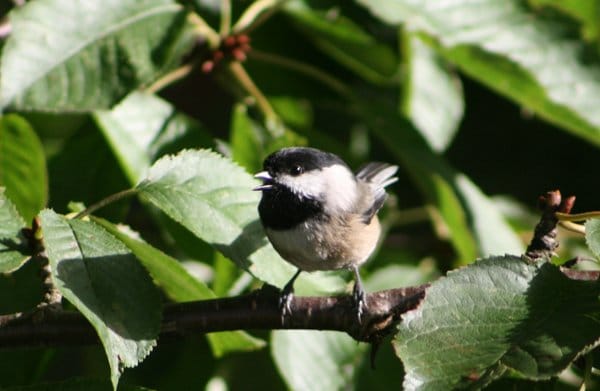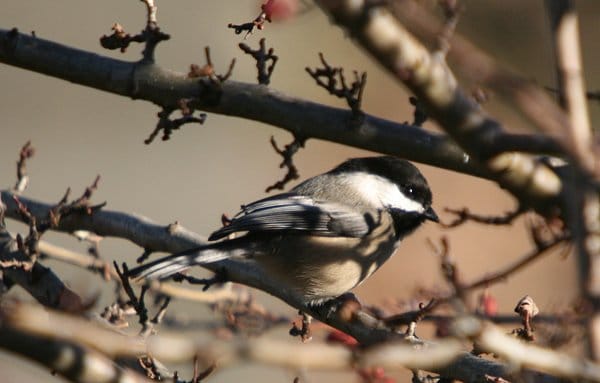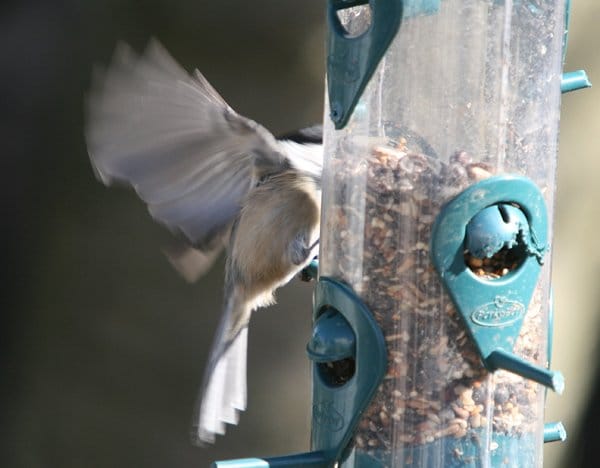If we can all agree on one thing, it’s that chickadees and tits are terrific birds. Who, after all, doesn’t love a chickadee? Not for nothing did 10,000 Birds readers elect the chickadee as the Most Beloved Backyard Bird of 2008; if we had run elections in other years, chickadees would no doubt have been front-runners. These birds certainly have a big fan in Alex Washoe, a freelance writer and bookseller in Seattle, WA. Alex, who publishes the bird and wildlife blog Birdland West, wants to share sincere feelings about a species near and dear to the hearts of many of us…
I’m new to birding, and I’ve lived in urban areas for many years where the bird population is mainly crows and pigeons. Last year, I moved out to the suburbs and was delighted to find many new species I wasn’t familiar with. Not long after the move my friend and I were walking our dogs, early in the morning, when the dogs discovered something tiny lying in the middle of the sidewalk. They were very curious, but unusually gentle. It took me a moment to realize it was a bird, and when I first saw it, I was sure it was dead. Just to make sure, however, I shooed the dogs away and checked it out. It was still alive.
Four several years, I’ve been a volunteer at a Wildlife Rehabilitation Center. I’ve had practice handling birds of all sizes (although the tiny songbirds still make me nervous). Springtime is the time of baby birds, and the Rehab Center is always flooded with them. I know about the common mistakes people make when they find young birds, assuming that because they’re on the ground with no other birds in sight they must be abandoned or in need of rescue. More often, the parents are nearby, just waiting for interfering humans to leave. Usually, the best course is to leave the baby where it is, or to observe for a while from a safe distance.
This time, though, the situation was different. I was pretty sure that this was not a baby bird — I wasn’t good enough then at identification to know what it was right away — but it was so sluggish I was afraid the cold might kill him if he stayed there any longer. I couldn’t tell if he was injured or not, but I didn’t think he was going to last long where he was — especially in a neighborhood filled with cats. So I carefully picked him up and carried him home. By the time I got there, he already seemed to be responding to the warmth of my hands. I outfitted a small box with towels, offered him some water, and then drove him as fast as I could to the Rehab center.
Even though I was too ignorant to identify the bird, the intake volunteer on the desk recognized him right away. “That’s a Black-Capped Chickadee,” she said.
And so I was introduced to the bird that has become a daily friend and pleasure. It turns out my neighborhood is full of chickadees. They were the first birds to find my new feeders, and by far the boldest. I have stood on my front steps, my head only a few feet away from the feeder, and watched chickadees eat. I’ve seen them look up at me with what I’d swear (unscientifically) is curiosity. They quickly adapt to the presence of humans (and even dogs) in the yard and don’t seem to be frightened by much of anything. My yard is also frequented by flickers and even Steller’s Jays, but none of those birds seem to ruffle the chickadees at all. They did get really upset about the pigeons who were raiding the feeders for a while. I would be alerted to the problem by the sound of half a dozen chickadees sitting in the branches around the feeder, chirping loudly at the pigeons. As soon as the bigger birds moved, the chickadees would continue with their feeding.
The familiar wheezing “chickadee–dee–dee” call has become so common in my yard that I actually get pangs of worry if I stand on my deck for a while and don’t hear it. What happened to my chickadees? It is also the only bird sound I can make a reasonable imitation of. (Not good enough to interest any actual chickadees, however.) All through the cold, gray, wet Seattle winter, the chickadees were daily visitors at my feeders, often perching on the rails of my deck, hanging out in the cherry tree. Along with Dark-eyed Juncos and Anna’s Hummingbirds, they are my most loyal avian friends.
The chickadee that I discovered on the sidewalk was suffering from dehydration and hypothermia. The Rehabbers guessed he hit something hard enough to be stunned, and then the cold overcame him. Fortunately, there were no broken bones, and he quickly resuscitated with care and feeding. A week later I was able to release him in a park near where I found him. I’ve been back many times to photograph chickadees there. It’s impossible to know, of course, but I like to think some of the photos may be my rescue. And that he brought his friends and family back to my feeders.
















Dear Alex,
thanks for sharing your passion for your bird friends – you have me really want to pay attention more, maybe get a feeder… I live in Ballard and my story is that I mostly see & hear crows and seagulls here – I miss waking to sweet-sounding songbirds, as I used to do in NJ
You’ve done a great deed indeed!
Chickadees are one of my favorite backyard birds. They were the first bird I ever hand fed and the first to nest in my bluebird boxes. There’s nothing quite like a chickadee telling you to hurry up when you’re filling your feeders!
I loved this little musing on chickadees, Alex! They are probably one of my top 10 favorite birds. I know they’re here in Chicago, but not really near where I live and I’m not allowed to hang a feeder.
So I’ve been a bit homesick for those cherubic faces and cheerful calls. (And nothing beats seeing Black Caps right after a snowfall!) Thanks for letting me live vicariously through you!